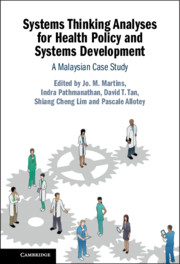| Population behaviour and demographic profile | Increased rural–urban migration By 1991, 51% of the population was urban Rapid rise in female literacy By 1997: 49% of primary school enrolment was female Resulted in: Rising literacy rate (72%) Improving health literacy Increased demand for allopathic medical care
| Improved access to basic STC services Increased demand for more sophisticated clinical care (investigation facilities, surgical services, specialist services) Outcome by the end of the period: Reduced disparities in access to care between geographic regions, especially between the West and East Coast states of Peninsular Malaysia
|
| Morbidity and mortality profile | Decline in major communicable diseases (CDs) Remaining burden from re-emerging (dengue, TB) and new CDs (HIV/AIDS) Rise in NCDs (cardiovascular, metabolic, neoplastic) and accidents
| Recognition of need for more sophisticated clinical care by policy-makers and politicians across the country Outcome by the end of the period: Improved quality of care in the public sector in terms of clinical outcomes, patient satisfaction and resource utilisation
|
| Economy and macro policies |
Improve quality (clinical outcomes, patient satisfaction, resource utilisation) Outsource some hospital support services Begin the growth of private sector hospital and specialist services
| Rise in private sector expenditure on health care (see Chapter 9) |
| Education sector | Better-qualified school levers were now demanding tertiary education. Tertiary education was expanded, including local production of doctors and various allied health professionals (see Chapter 8). This contributed to changing the profile of the health workforce in hospitals.
| Increased the demand for medical education by increasing the visibility and prestige of doctors and specialists (see Chapter 8) |
| | |
| Other modalities of healthcare delivery | Notification of CDs (dengue) improved through collaboration between the disease control programme and STC services. Support from STC to the PHC level was strengthened through the QAP, whereby senior specialists in state-level hospitals had to take responsibility for quality in their discipline in district hospitals and health centres (e.g. maternal health, paediatrics, surgery).
| |
| More doctors became available. There was brain drain of doctors and nurses from the public to the private sector. The competence and remuneration of nurses and hospital assistants (medical assistants) was upgraded. More specialised categories of allied health personnel were recruited or trained to support the growing number of specialist services. Management skills in public sector hospitals were upgraded.
|
Increased local production Increased financial support for foreign training of local candidates (doctors and dentists) Establishment of local training programmes for a wider range of allied health personnel
|
| Governance | ‘Regionalisation’ of hospitals to improve geographic distribution of specialist services Improved financial literacy of hospital managers Improved community participation (hospital boards)
| Increased recognition of safety and quality issues in smaller private sector providers of inpatient care Increasing influence of clinical specialists in health policy and programme management Improved linkages with some public sector health programmes (disease control, e.g. dengue notification, clinical management protocol)
|
| Healthcare financing | Progressive decentralisation of financial authority and responsibility to state-level hospitals (modified budgeting system) | In 1985:
% national budget allocated to health: 4.3% % GNP for health: 1.68% Public sector funded 75% of THE 13% of MoH budget spent on development
Demand for increasing share of the government budget for the health sector because of higher-cost personnel and high-cost technology |
| Health information | Better quality and timeliness of hospital data facilitated Better allocation of resources (human, materials) Improved monitoring of performance (utilisation, clinical quality, patient satisfaction) Strengthened capacity for and production of health technology assessment contributed to rational acquisition of technology and products in the MoH network
| Monitoring of quality of care in hospitals strengthened the quality of data generated in hospitals, e.g. causes of death, ICD coding Strengthened capacity for clinical trials and management research in hospitals Improved communication with patients (health promotion, patient education)
|



